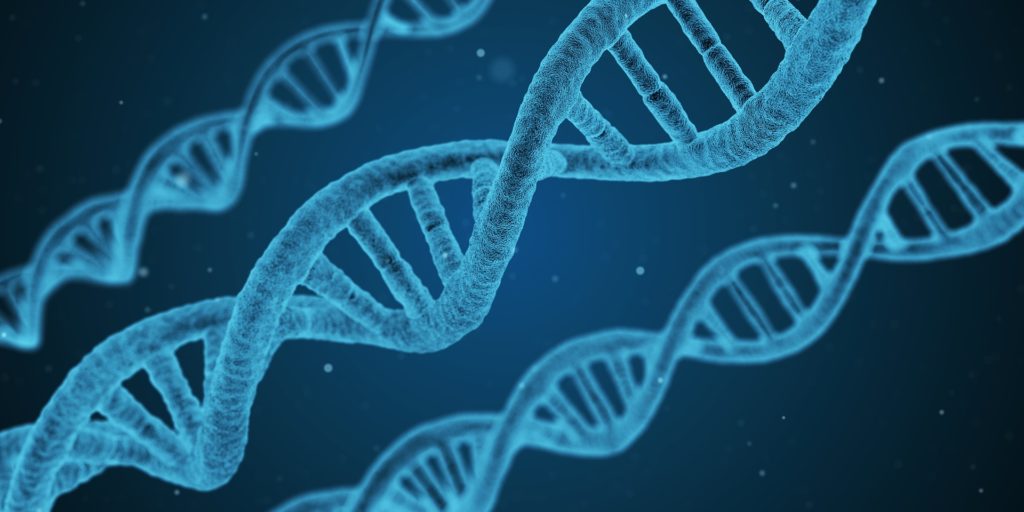Each individual possesses a unique genetic information, or genome, that is present in all cells in their body. This information, which is stored in the DNA, is determined by the specific nucleotide sequence. However, the DNA sequence is not the only factor that can determine or modulate gene function. Gene expression is also modulated by changes in the epigenome, which comprises all the chemical modifications to DNA and histone proteins.
In this article we will talk about DNA methylation, an important epigenetic mechanism, and describe how this mechanism is altered in cancer cells. We also highlight how saliva samples are comparable to blood samples in DNA methylation studies.

DNA methylation as an epigenetic mechanism
The term “epigenetics” refers to the set of mechanisms that regulate gene expression without affecting the nucleotide sequence of the DNA. Epigenetic mechanisms can be sub-divided into two types:
1.- Those affecting chromosomal proteins, thus altering the structure of DNA and affecting the interaction between proteins and DNA. This mechanism involves post-translational modifications in the histones, which regulate the degree of chromatin packaging and, therefore, gene expression.
2.- Those mechanisms that involve chemical modification of the DNA strand. In this case, DNA methylation is one of the most widely studied and is the subject of this article.
DNA methylation involves the enzymatic addition of a methyl group to cytosine and generally occurs in gene regions rich in cytosine and guanine dinucleotides (CpG). It occurs in gene-regulating regions and represents a mechanism for suppressing gene expression. Thus, when a gene is expressed exclusively in a specific cell type, it is probably methylated in all other cell types. Consequently, although all cells in an organism contain the same DNA sequence, their methylation pattern is different.
Moreover, in contrast to the DNA sequence, which is inherited from the progenitors’ gametes, DNA methylation markers are not inherited from the gametes. This is because, once the zygote has formed, the majority of these marks are eliminated or deleted to subsequently establish a “de novo” methylation pattern. This pattern forms the basis for the development of different organs and tissues and is generated in a programmed manner during embryonic development. Methylation markers are maintained after cell division, thus facilitating DNA packaging in the form of chromatin and representing a molecular “memory” mechanism that stores information about the genes that are expressed, or not, in specific cell types.
In addition to the methylation changes that occur during embryonic development, changes to the methylation pattern of an individual’s genome also occur gradually throughout their lifetime. These changes occur in all cells in our body, but at different rates in each tissue. Environmental factors, such as diet and lifestyle, may affect these epigenetic changes. However, we still do not fully understand the underlying mechanisms for how each factor impacts on gene expression.
Methylation and cancer
Cancer cells are known to have a different methylation pattern to that observed in healthy tissues. Two types of changes can be distinguished:
- Genome regions that are not typically methylated, such as CpG sites, are found to be modified in cancer cells.
- Cancer cells are characterized by exhibiting a high degree of demethylation in regions associated with the nuclear lamina.
Additionally, many of the mutations found in cancer cells affect genes involved in epigenetic regulation, which could also contribute to the observed phenotype. It should be noted that some of these modifications have also been observed in healthy tissue from elderly individuals. Therefore, it is possible that age-related changes to methylation and those associated with cancer share some underlying mechanisms.
Although current technologies allow us to detect these changes to the epigenome, the current challenge is to be able to distinguish between those which have an effect on the development of cancer from those arising as the result of the disease. In other words, to identify which alterations to the methylation pattern result in activation or inactivation of a particular gene and, as a result of it, contribute to cell transformation or cancer progression. While it is possible that many of the changes observed do not play an important role, it is likely that those genes which participate in signaling pathways related to the hallmarks of cancer are involved. For instance, genes associated with controlling cell proliferation, the immune system or cell death, amongst others.
It has been reported that the gene Ripk3 is silenced in various types of cancer and exhibits methylation marks close to the transcription start site. This gene is essential for initiating a type of cell death known as necroptosis. When its expression is suppressed, cancer cells become resistant to this type of death. The use of demethylating agents removes the methylation marks present in Ripk3, thereby reestablishing its expression and restoring the ability of cancer cells to undergo necroptosis. In this case, it is known that changes to Ripk3 expression arise during tumor development as a result of expression of the oncogenes Braf or Axl, although the mechanisms for how these oncogenes modulate Ripk3 expression are not yet known.
It should be noted that although demethylation appears to be an effective therapeutic strategy in some types of cancer, in other types the opposite effect is achieved. The inhibition of DNA methylation in a murine intestinal cancer model has allowed the number of adenomas to be reduced significantly. The same applies to models of breast and lung cancer.. However, in contrast to the above, methylation inhibition resulted in an acceleration of certain leukemias.
To understand cancer epigenetic changes will be of value from a therapeutic and diagnostic perspective. DNA methylation studies can be performed from both tissue and liquid (blood, urine, sputum, etc.) biopsies. The latter will contain molecules associated with cancer progression, inflammation and cell death, as well as circulating tumor cells (CTCs). As they are obtained non-invasively, they are extremely useful in those cases in which a tumor tissue biopsies cannot be obtained and also as a means of monitoring disease progression. The identification of epigenetic biomarkers in cancer, as well as the development of in vitro diagnostic tests (IVDs), has increased markedly in recent years. Indeed, various tests that use liquid biopsies and epigenetic biomarkers to detect cancer are now available. Their main disadvantage is that, as they are based on detecting the DNA from tumor cells (tcDNA), they typically present low sensitivity for detecting tumors in the early stages of development. This is due to the fact that tcDNA levels typically increase with cancer progression. The development of tests with higher sensitivity and specificity will be key to detect cancer in early stages.
DNA methylation studies: Blood versus saliva
Epigenetic studies have typically used blood rather than saliva samples. However, the development of devices that allow saliva samples to be collected, and the donor DNA to be stabilized, in a simple manner and with no need for medical staff, represents an advantage for both the donor and researchers.
In order to determine the utility of saliva samples for detecting DNA methylation patterns, Murata et al. have performed a study comparing blood and saliva samples from the same donor. Their findings indicated that there is a high correlation between the methylation patterns observed in the DNA from both sample types. These authors also studied methylation in some CpG regions in which individual differences had been observed when using blood samples. They found that these differences inherent to each individual were also found in saliva.
Consequently, the isolation of DNA from saliva samples is both comparable to that obtained from blood for genetic studies and can also be used to study the epigenome, in particular DNA methylation.
References
[1] Bergman, Yehudit, and Howard Cedar. 2013. “DNA Methylation Dynamics in Health and Disease.” Nature Structural & Molecular Biology 20 (3): 274–81. https://doi.org/10.1038/nsmb.2518.
[2] Dor, Yuval, and Howard Cedar. 2018. “Principles of DNA Methylation and Their Implications for Biology and Medicine.” Lancet (London, England) 392 (10149): 777–86. https://doi.org/10.1016/S0140-6736(18)31268-6.
[3] Koo, Gi-Bang, Michael J Morgan, Da-Gyum Lee, Woo-Jung Kim, Jung-Ho Yoon, Ja Seung Koo, Seung Il Kim, et al. 2015. “Methylation-Dependent Loss of RIP3 Expression in Cancer Represses Programmed Necrosis in Response to Chemotherapeutics.” Cell Research 25 (6): 707–25. https://doi.org/10.1038/cr.2015.56.
[4] Locke, Warwick J, Dominic Guanzon, Chenkai Ma, Yi Jin Liew, Konsta R Duesing, Kim Y C Fung, and Jason P Ross. 2019. “DNA Methylation Cancer Biomarkers: Translation to the Clinic.” Frontiers in Genetics 10: 1150. https://doi.org/10.3389/fgene.2019.01150.
[5] Luo, Huiyan, Wei Wei, Ziyi Ye, Jiabo Zheng, and Rui-Hua Xu. 2021. “Liquid Biopsy of Methylation Biomarkers in Cell-Free DNA.” Trends in Molecular Medicine 27 (5): 482–500. https://doi.org/10.1016/j.molmed.2020.12.011.
[6] Murata, Yui, Ayaka Fujii, Sho Kanata, Shinya Fujikawa, Tempei Ikegame, Yutaka Nakachi, Zhilei Zhao, et al. 2019. “Evaluation of the Usefulness of Saliva for DNA Methylation Analysis in Cohort Studies.” Neuropsychopharmacology Reports 39 (4): 301–5. https://doi.org/10.1002/npr2.12075.
Would you like to learn more about kits for collecting DNA from saliva samples for performing DNA methylation studies?
Click here to get more information.




